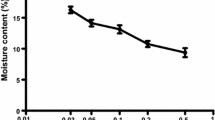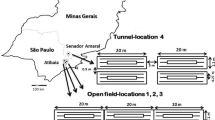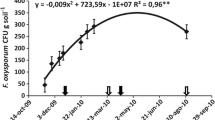Abstract
The survival of Fusarium pseudograminearum (Fp) in wheat straw was reduced significantly (P<0.05) when the straw was sprayed with spores of isolate BM1 of Trichoderma koningii (Tk), incorporated into an acid red duplex soil and incubated for 4 months at two temperatures (15°C and 25°C) and at three water potentials (−0.03 MPa. −0.3 MPa and < −50 MPa). The greater reduction of the pathogen in the moist soil (−0.3 MPa) compared with the wet soil (−0.03 MPa) at both temperatures was associated with greater colonisation of the straw by Tk. After 6 months at 25°C in the moist soil, the pathogen was completely eliminated from the straw pieces and replaced by Tk. In air-dry soil (< −50 MPa), Fp survived in 100% of the straw pieces even after 6 months at either temperature. When infested straw was sprayed with seven antagonistic isolates of Trichoderma spp. and incorporated into either an alkaline black earth or an acid red duplex soil, the survival of the pathogen was generally greater in the alkaline black earth. However, another Tk isolate (TW3) and a T. harzianum (Th) isolate (TW7) reduced the survival of the pathogen to low levels (3–30%) after 3 months at 30°C in both soils. The results suggest that it may be possible, at least in the summer-dominant rainfall wheat are as of Australia, for Trichoderma species to reduce substantially the inoculum of Fp during the 6-month fallow period.
Similar content being viewed by others
References
Bae Y-S, Knudsen GR (2001) Influence of a fungus-feeding nematode on growth and biocontrol efficacy of Trichoderma harzianum. Phytopathology 91, 301–306.
Brennan JP, Murray GM (1988) Australian wheat diseases: assessing their economie importance. Agricultural Science (Journal of the Australian Institute of Agricultural Science) New Series 1, 26–35.
Burgess LB, Liddell CM, Summerell BA (1988) ‘Laboratory Manual of Fusarium Research’ (2nd Edition) (Department of Plant Pathology and Agricultural Entomology, University of Sydney, Australia)
Chan KY, Mead, JA, Roberts WP (1987) Poor early growth of wheat under direct-drilling. Australian Journal of Agricultural Research 38, 791–800.
Chet I (1990) Biological control of soilborne plant pathogens with fungal antagonists in combination with soil treatments. In ‘Biological Control of Soilborne Plant Pathogens’. (Ed. D Hornby) pp. 15–25. (CAB International: Wallingford, Oxford, UK)
Chet I, Baker R (1981) Isolation and biocontrol potential of Trichoderma hamatum from soil naturally suppressive to Rhizoctonia solani. Phytopathology 71, 286–290.
Dandurand LM, Knudsen GR (1993) Influence of Pseudomonas fluorescens on hyphal growth and biocontrol activity of Trichoderma harzianum in the spermosphere and rhizosphere of pea. Phytopathology 83, 264–270.
Deka RN, Wairui M, Mtakwa PW, Mullins CE, Veenendaal EM, Townend J (1995) Use and accuracy of the filter-paper technique for the measurement of soil matric potential. European Journal of Soil Science 46, 233–238.
Duffy BK, Simon A, Weller DM (1996) Combination of Trichoderma koningii with fluorescent Pseudomonas for control of take-all on wheat. Phytopathology 86, 188–194.
Fravel DR (1999) Hurdles and bottlenecks on the road to biocontrol of plant pathogens. Australasian Plant Pathology 28, 53–56.
Holloway GJ, Henry FJ, Exell GK, Abubaker A (1999) The incidence and causal agents of crown rot in wheat crops in western Victoria. In ‘Proceedings of the First Australasian Soilborne Diseases Symposium’. Gold Coast, Qld, 8–10 Feb., 1999. pp.199–200.
Klein TA, Summerell BA, Burgess LW (1988) Influence of stubble-management practices on crown rot of wheat. Plant Protection Quarterly 3, 10–11.
Lai P, Bruehl GW (1966) Survival of Cephalosporium gramineum in naturally infested wheat straws in soil in the field and in the laboratory. Phytopathology 56, 213–218.
Lewis JA, Papavizas GC (1991) Biocontrol of plant disease: the approach for tomorrow. Crop Protection 10, 95–105.
Lumsden RD, Lewis JA, Fravel DR (1995) Formulation and delivery of biocontrol agents for use against soilborne plant pathogens. In ‘Biorational Pest Control Agents’. (Eds FR Hall, JW Barry) pp. 166–182. (American Chemical Society: Washington, DC, USA)
Northcote KH, Hubble GD, Isbell RF, Thompson CH, Bettenay E (1975) ‘A Description of Australian Soils’. (CSIRO Publications: Melbourne)
Papavizas GC (1985) Trichoderma and Gliocladium: biology, ecology and potential for biocontrol. Annual Review of Phytopathology 23, 23–54.
Ryder MH, Simon A, Terrace TE, Rovira AD, Harch BD, Yang H, Zhang X,Tang WH (1999) Biological control of take-all and sharp eyespot of wheat in the field using Trichoderma koningii. In ‘Proceedings of the First Australasian Soilborne Diseases Symposium’. Gold Coast, Qld, 8–10 Feb., 1999. pp. 97–98.
Shi WL, Wong PTW (1996) Biocontrol of take-all and crown rot by Trichoderma spp. In ‘Advances in Biological Control of Plant Diseases’. (Eds WH Tang, RJ Cook and AD Rovira.) pp. 131–132. (China Agricultural University Press: Beijing, China)
Simon A (1989) Biological control of take-all of wheat by Trichoderma koningii under controlled environmental conditions. Soil Biology and Biochemistry 21, 323–326.
Simon A, Sivasithamparam K (1988) The soil environment and the suppression of saprophytic growth of Gaeumannomyces graminis var. tritici. Canadian Journal of Microbiology 34, 865–870.
Summerell BA, Burgess LW (1988) Stubble management practices and the survival of Fusarium graminearum Group 1 in wheat stubble residues. Australasian Plant Pathology 17, 88–93.
Wildermuth GB, McNamara RB (1994) Testing wheat seedlings for resistance to crown rot caused by Fusarium graminearum Group 1. Plant Disease 78, 949–953.
Wildermuth GB, McNamara RB, Spark T (1999) Different expressions of resistance to crown rot in wheat. In ‘Proceedings of the First Australasian Soilborne Diseases Symposium’. Gold Coast, Qld, 8–10 Feb., 1999. pp. 79–80.
Author information
Authors and Affiliations
Corresponding author
Rights and permissions
About this article
Cite this article
Wong, P.T.W., Mead, J.A. & Croff, M.C. Effect of temperature, moisture, soil type and Trichoderma species on the. Australasian Plant Pathology 31, 253–257 (2002). https://doi.org/10.1071/AP02020
Received:
Accepted:
Issue Date:
DOI: https://doi.org/10.1071/AP02020




